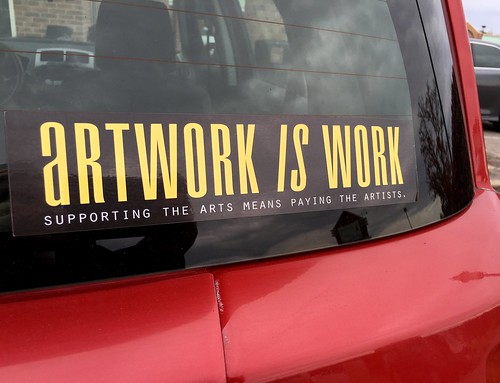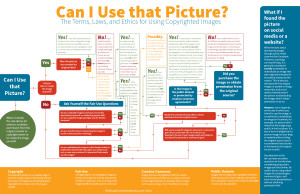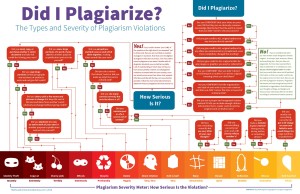How to determine fair use
Last modified 12 November 2015.
So you figured out the status of a work you or a patron want to access. This page provides tips on the if and how of fair usage.

Artists, inventors, researchers, students, enthusiasts — creators deserve attribution, and those who make a living from such effort and works should earn fair economic compensation. But what is fair use of others’ works? There are four factors when assessing fair use: purpose of use, nature of copyrighted work, the amount used, and potential market effects. In addition, the posts on DRM and the DMCA, finding public domain and DRM-free content, and copyright information literacy will also help!
Articles & organizations
Regarding printed media, both Google Books and HathiTrust won cases against the Authors Guild to scan and freely make available online book content:
- Big Win For Fair Use In Google Books Lawsuit (C. McSherry, 16 October 2015).
- Google Books, Fair Use, and the Public Good (K. Smith, 18 October 2015), including an excellent definition of transformative work and how that is a form of fair use, i.e., “an answer to the question of how borrowing from a copyrighted work can be justified.”
- Authors Guild Drops HathiTrust Case (A. Albanese, 8 January 2015).
- HathiTrust Digital Library Wins Latest Round in Battle With Authors (J. Howard, 10 June 2014).
Visual media
Center for Media & Social Impact (CMSI) has a huge collection of documents on fair use — best practices, teaching materials, etc., for visual arts (video, film, television, documentaries), journalism, and much more.
Can I use that picture? The terms, laws, and ethics for using copyrighted images, by Curtis Newbold (14 July 2014) provides a handy visual guide on determining fair use of images.

Archives & other special collections
Special Collections and Archives in the Digital Age, published by ARL in June 2012 provides guidance on digitization, permissions, donor agreements, etc., for libraries, museums, archives, and other special collections.
Born Digital: Guidance for Donors, Dealers, and Archival Repositories, by the Council on Library and Information Resources (CLIR, 2013).
Northeast Document Conservation Center (NEDCC) is well known for helpful guides on preservation in both analog and digital media.
Jisc (formerly called Joint Information Systems Committee), while based in the UK, offers detailed infokits and guides on management and digitization projects.
Educational uses
Newbold has another useful article and accompanying infographic, Did I plagiarize? The types and severity of plagiarism violations (16 September 2014).

Final Report from the Conference on Fair Use (CONFU) in 1998 had a conservative take on educational use of multimedia.
Music
Music Library Association’s FAQ on copyright
Music & copyright tips from Washington State University
Tools
University of Minnesota Libraries’ Thinking Through Fair Use tool offers a helpful form and checklist on how to gauge fair usage, using the four factors of evaluation.
ALA’s Copyright Advisory Network offers several interactive copyright tools:
- The Copyright Genie
- Fair Use Evaluator
- Public Domain Slider (requires Flash)
- Section 108 Spinner (requires Flash)
- Exemptions for Instructors eTool
Stanford University offers additional tools for teaching, as well as tips on permissions, and best practices for archivists, media studies, dance materials, cinema, and more.
Web2Rights’ calculator helps assess risk for open education resources.
Books
Copyright & Cultural Institutions: Guidelines for Digitization for U.S. Libraries, Archives, and Museums (2009), by Peter B. Hirtle, Emily Hudson, and Andrew T. Kenyon, is a PDF book available for free under the Creative Commons BY-NC-ND 3.0 US license. It’s especially relevant to determining fair use:
- Read Chapter 2 for a thorough listing of the media and formats protected by copyright (many!). Moreover:
- Do look at the thorough the provisions checklist 6.8 on pp. 127-128.
- Table 5.1 (pp. 88-89): Formats and areas with Title 17 exemptions
- Flowchart 6.1 (p. 108): Cultural institutions exempted from Title 17
- Table 6.2 (p. 125): Decision guidelines when a user, patron, or student makes a request for a copyrighted work
- If you’re an archivist or work on a digital library or repository, refer to these charts to help in evaluating the risk in digitization projects and preservation management:
- Flowchart 1 (p. 3): Overview of copyright issues
- Flowchart 2 (p. 17): Describing the nature of a work
- Flowchart 6.2 (p. 117): More on digitization provisions
- Table 10.1 (p. 194-195): Riskier factors towards copyright infringement
- Flowchart 10.1 (p. 2.03): Safer digitization workflow
If you’re concerned about fair use of music and audio works, definitely read Dwayne K. Butler’s “Music and Copyright,” chapter 15 (pp. 111-118) within Kenneth D. Crews Copyright Law for Librarians and Educators: Creative Strategies & Practical Solutions (3rd edition, 2012, ALA). An important term to understand is nondramatic — which is not the same as nonfiction! Nondramatic refers to works with implied or explicit performance aspects. For instance, text-to-speech reading from screen readers (VoiceOver on Mac OS X/iOS, JAWS on Windows) and automated/generated read aloud feature of readers and electronic devices would likely be considered nondramatic. By contrast, audiobooks would likely be considered dramatic, as they are often read as a performance, like a radio play, opera, and so on.
Government resources
Worthwhile sections of Title 17 to read concerning fair use include:
- Section 102: Subject matter of copyright
- Section 105: Subject matter regarding US government works
- Section 106: Exclusive rights, i.e., specific protections of copyright: reproduce, derivative works, distribution and copies, public performances, and transmission
- Section 107: Fair use description
- Section 108: Exemptions for libraries and archives
- Section 109: Effect on transfer, including the crucial Doctrine of First Sale, which protects libraries when loaning out materials they purchase
- Sections 110(1) & 110(2): Exemptions for certain performances and displays
- Section 121, a.k.a., the Chafee Amendment, providing reproduction exemption for persons with disabilities
- Section 201: Ownership of copyright, including initial ownership, works for hire (e.g., contracted work), contributions to collections, transfers both voluntary and otherwise
- Section 203: Termination of copyright transfers and licenses granted by author
- Section 302: Copyright duration for works created on or after January 1, 1978
- Section 303: Copyright duration for works not published or copyrighted before January 1, 1978
- Section 304: Duration of copyright, especially concerning renewals and extensions
The TEACH Act of 2001 (House & Senate bills for Technology, Education, and Copyright Harmonization) outlines copyright and fair use for educational contexts.
Court cases on fair use
Speaking of fair use in classrooms, two court cases help defend using electronic resources and streaming video online and in distance learning:
- Association of American Publishers vs. Georgia State University: Georgia State was able to maintain the vast majority its electronic course reserves.
- Association for Information and Media Equipment vs. University of California, Los Angeles: The judge threw out the case against UCLA concerning streaming video for online courses.
US Copyright Fair Use Index is a searchable database on cases regarding fair use and copyright.
Stanford has useful fair use case summaries, organized by media and format.
Unfortunately, cases of copyright infringement in music have been stringent,often favoring the copyright holder.
![]() How to determine fair use by Sarah Liberman is licensed under a Creative Commons Attribution-NonCommercial-ShareAlike 4.0 International License.
How to determine fair use by Sarah Liberman is licensed under a Creative Commons Attribution-NonCommercial-ShareAlike 4.0 International License.
Irony that article on copyright and fair use shows photo with misattribution of design of bumpersticker and incorrectly attributed artist didn’t set it straight. So the real artist isn’t getting paid.
Totally, Milos! I’ll edit the image’s caption with that in mind, by linking to the Laughing Squid article that corrects attribution.